Practicing the CBSE Sample Papers for Class 10 Maths Basic Set 9 allows you to get rid of exam fear and be confident to appear for the exam.
CBSE Sample Papers for Class 10 Maths Basic Set 9 with Solutions
Time Allowed : 3 hours
Maximum Marks : 80
General Instructions:
- This Question Paper has 5 Sections A, B, C, D, and E.
- Section A has 20 Multiple Choice Questions (MCQs) carrying 1 mark each.
- Section B has 5 Short Answer-I (SA-I) type questions carrying 2 marks each.
- Section C has 6 Short Answer-Il (SA-II) type questions carrying 3 marks each.
- Section D has 4 Long Answer (LA) type questions carrying 5 marks each.
- Section E has 3 Case Based integrated units of assessment (4 marks each) with sub-parts of the values of 1,1 and 2 marks each respectively.
- All Questions are compulsory. However, an internal choice in 2 Qs of 2 marks, 2 Qs of 3 marks and 2 Questions of 5 marks has been provided. An internal choice has been provided in the 2 marks questions of Section E.
- Draw neat figures wherever required. Take n = \(\frac{22}{7}\) wherever required if not stated.
Section – A
(Section A consists of 20 Questions of 1 marks each.)
Question 1.
The simplest form of \(\frac{\sqrt{45}+\sqrt{20}}{\sqrt{5}}\) is: [1]
(A) 5\(\sqrt{5}\)
(B) 5
(C) 2\(\sqrt{5}\)
(D) \(\sqrt{5}\)
Answer:
Option (B) is correct.
Explanation:
\(\frac{3 \sqrt{5}+2 \sqrt{5}}{\sqrt{5}}\)
= \(\frac{5 \sqrt{5}}{\sqrt{5}}\) = 5
Question 2.
The pair of equations y = 0 and y = – 7 has :
(A) one solution
(B) two solutions
(C) infinitely many solutions
(D) no solution
Answer:
(D) no solution
Explanation :
We know that equation of the form y = a is a line parallel to x-axis at a distance ‘a’ from it. y = 0 is the equation of the x-axis and y = -7 is the equation of the line parallel to the x-axis. So, these two equations represent two parallel lines.
Therefore, there is no solution.
![]()
Question 3.
Which of the following equations has 2 as a root?
(A) x² – 4x + 5 = 0
(B) x² + 3x – 12 = 0
(C) 2x² – 7x + 6 =0
(D) 3x² – 6x – 2= 0
Answer:
(C) 2x² – 7x + 6 =0
Explanation:
Put the value of x = 2 in 2x² – 7x + 6 = 0
2 × (2)² – 7 × 2 + 6 = 0
8 – 14 + 6 = 0
14 – 14 =0
So, x = 2 is a root of 2x² – 7x + 6 = 0
Question 4.
The sum of first five multiples of 3 is :
(A) 45
(B) 55
(C) 65
(D) 75
Answer:
(A) 45
Explanation:
In the given AP, a =3, d = 3 and n = 5
Thus,
Sn = \(\frac{n}{2}\)[2a+(n-1)d\
Sn = \(\frac{5}{2}\) [2 × 3 +(5-1) × 3]
= 45
Question 5.
The distance of the point P (-6, 8) from the origin is :
(A) 8 units
(B) 2\(\sqrt{7}\) units
(C) 10 units
(D) 6 units 1
Answer:
(C) 10 units
Explanation :
Distance between two points (x1, y1) and (x2, y2) is given as,
d= |}\(\sqrt{\left(x_2-x_1\right)^2+\left(y_2-y_1\right)^2}\)|
Where, x1 = -6, y1 = 8
and x2 = 0, y2 = 0
So, distance between P (-6,8) and origin O (0,0) is given by,
PO = \(\sqrt{[0-(-6)]^2+[(0-8)]^2}\)
= \(\sqrt{(6)^2+(-8)^2}\)
= \(\sqrt{36 + 64}\)
= \(\sqrt{100}\)
= 10 units.
![]()
Question 6.
In the figure given below, ZBAC = 90° and AD ⊥ BC. Then:
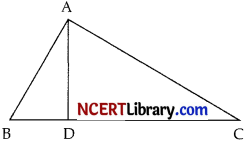
(A) BD × CD = BC²
(B) AB × AC = BC²
(C) BD × CD = AD²
(D) AB × AC = AD²
Answer:
(C) BD × CD = AD²
Explanation:
In ∆ABD and ∆CAD,
∠ADB = ∠ADC = 90 and ∠ABD = ∠CAD = θ.
By A4 Similarity, we get
∆ABD ~ ∆CAD
⇒ \(\frac{A D}{B D}=\frac{C D}{A D}\)
⇒ BD × CD = AD²
Question 7.
Which of these numbers can be expressed as a product of two or more prime numbers?
(i) 15
(ii) 34568
(iii) (15 x 13)
(A) only (ii)
(B) only (iii)
(C) only (i) and (ii)
(D) All – (i), (ii) and (iii)
Answer:
(D) All – (i), (ii) and (iii)
Explanation:
All of the three numbers can be expressed as a product of prime numbers, write factors of all number.
Question 8.
The point P on x-axis equidistant from the points A(-1,0) and B(5, 0) is:
(A) (2,0)
(B) (0,2)
(C) (3,0)
(D)(2,2)
Answer:
(A) (2,0)
Explanation: Let the position of the point P on x-axis be (x, 0), then
PA² = PB²
⇒ (x + 1)² + (0)² = (5 – x)² + (0)².
⇒ x² + 2x + 1= 25 + x² – 10x
⇒ 2x + 10x = 25 – 1
⇒ 12x = 24 ⇒ x = 2
Hence, the point P (x, 0) is (2,0).
Question 9.
In figure PQ and PR are two tangents to a circle with centre O. If ∠QPR = 46°, then ∠QOR equals :
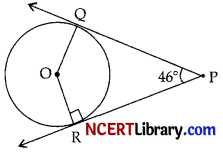
(A) 67°
(B) 134°
(C) 44°
(D) 46°
Answer:
(B) 134°
Explanation:
In quadrilateral PQOR,
∠QPR + ∠PRO + ∠QOR + ∠PQO = 360°
46° + 90° + ∠QOR + 90° = 360°
[∠PRO = ∠PQO = 90°]
∠QOR = 360° – 226°
∠QOR =134°
![]()
Question 10.
If ∆ABC is right angled at C, then the value of cos (A+B) is :
(A) 0
(B) 1
(C) \(\frac{1}{2}\)
(D) \(\frac{\sqrt{3}}{2}\)
Answer:
(A) 0
Explanation :
In ∆ABC,
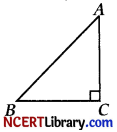
sum of three angles = 180° i.e.,
∠A + ∠B + ∠C = 180
∠C = 90 [Given]
∠A + ∠B + 90° = 180°
⇒ A + B = 90° 1
cos(A + B) = cos 90° = 0
Question 11.
If the ratio of the length of a vertical rod and the length of its shadow is 1: \(\sqrt{3}\) , then the angle of elevation of the sun at that moment is:
(A) 60°
(B) 45°
(C) 90°
(D) 30°
Answer:
(D) 30°
Explanation:
Let AB be a vertical rod and BC be its shadow.
From the figure,
∠ACB = θ
In ∆ABC,
tan θ = \(\frac{AB}{BC}\)
⇒ tan θ = \(\frac{1}{\sqrt{3}}\)
⇒ tan θ = tan 30°
⇒ θ = 30°
Hence, the angle of elevation of the sun is 30°.
Question 12.
If the point P(k, 0) divides the line segment joining the points A(2, -2) and B(-7,4) in the ratio 1 : 2, then the value of k is:
(A) 1
(B) 2
(C) -2
(D) -1
Answer:
(D) -1
Explanation:

k = \(\frac{1(-7) + 2(2)}{1+2}\)
[x = \(\frac{1(-7) + 2(2)}{1+2}\)]
k = \(\frac{m x_2+n x_1}{m+n}\)
⇒ k = \(\frac{-7 + 4}{3}\)
⇒ 3k = -3
⇒ k = -1
Question 13.
If the sum of the circumferences of two circles with radii R1, and R2 is equal to the circumference of a circle of radius R, then:
(A) R1 + R2 = R
(B) R1 + R2 > R
(C) R1 + R2 < R
(D) Nothing definite can be said about the relation among R1, R2 and R [1]
Answer:
(A) R1 + R2 = R
Explanation:
According to question, Circumference of circle = Circumference of first circle + Circumference of second circle
2πR = 2πR1 + 2πR2
R1 + R2 = R
Question 14.
Area of the largest triangle that can be inscribed in a semi-circle of radius ‘r’ units is [1]
(A) r² sq. units
(B) \(\frac{1}{2}\)r² sq. units
(C) 2r² sq. units
(D) \(\sqrt{2}\)r² sq. units
Answer:
(A) r² sq. units
Explanation :
Take a point C on the circumference of the semi-circle and join it by the end points of diameter AB.
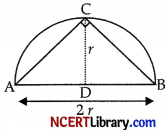
∠C = 90° [Angle in a semi-circle is right angle]
= \(\frac{1}{2}\) × 2r × r
= r² sq. units
Question 15.
A cylindrical pencil sharpened at one edge is the combination of [1]
(A) A cone and a cylinder
(B) Frustum of a cone and a cylinder
(C) A hemisphere and a cylinder
(D) Two cylinders
Answer:
(A) A cone and a cylinder
Explanation :
The sharpened part of the pencil is cone and unsharpened part is cylinder.
![]()
Question 16.
If x/s are the mid-points of the class intervals of grouped data,fi are the corresponding frequencies and \(\bar{x}\) is the mean, then \(\sum\left(f_i x_i-\bar{x}\right)\) is equal to: [1]
(A) 0
(B) -1
(C) 1
(D) 2
Answer:
(A) 0
Explanation:
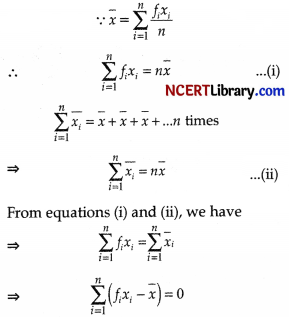
Question 17.
The probability that a non-leap year selected at random will contain 53 Sundays is : [1]
(A) \(\frac{1}{7}\)
(B) \(\frac{2}{7}\)
(C) \(\frac{3}{7}\)
(D) \(\frac{5}{7}\)
Answer:
(A) \(\frac{1}{7}\)
Explanation:
(A) \(\frac{1}{7}\)
Explanation :
Number of days in non-leap year = 365
Number of weeks = \(\frac{365}{7}\) = 52\(\frac{1}{7}\) = 52 weeks
Number of days left = 1
For example, it may be any of 7 days which from Sunday, Monday, Tuesday, Wednesday, Thursday, Friday and Saturday; so,
T(£) = 7
F(E) = 1 (Sunday)
P(F) = \(\frac{F(E)}{T(E)}\) = \(\frac{1}{7}\)
Question 18.
The HCF of 240 and 228 is: [1]
(A) 12
(B) 15
(C) 18
(D) 16
Answer:
(A) 12
Explanation:
Since, 240 = 24 × 3 × 5
and 228 = 22 × 3 × 19
Hence, HCF of 240 and 228 = 12.
Directions for question 19 & 20: In the following questions, A statement of Assertion (A) is followed by a statement of Reason (R). Choose the correct option:
(A) Both (A) and (R) are true and (R) is the correct explanation of (A).
(B) Both (A) and (R) are true but (R) is NOT the correct explanation of (A).
(C) (A) is true but (R) is false.
(D) (A) is false and (R) is true.
Question 19.
Assertion (A): A bag contains slips numbered from 1 to 100. If Fatima chooses a slip at random from the bag, it will either be an odd number or an even number. Since this situation has only two possible outcomes, the probability of each is \(\frac{1}{2}\).
Reason (R): When we toss a coin, there are two possible outcomes: head or tail. Therefore, the probability of each 1
outcome is \(\frac{1}{2}\).
Answer:
(B) Both (A) and (R) are true but (R) is NOT the correct explanation of (A).
Explanation :
In case of assertion:
From 1 to 100 numbers, there are 50 even and 50 odd numbers.
Total number of outcomes T(E) = 100
Number of outcomes favourable for event E (even numbers) = F(E) = 50
So, P(E) = \(\frac{50}{100}\) = \(\frac{1}{2}\)
Similarly, the probability of getting odd numbers = \(\frac{1}{2}\)
Hence the probability of getting odd and even each = \(\frac{1}{2}\).
Hence, the given statement is true.
∴ Assertion is correct.
In case of reason:
Since, there are two outcomes equal in all manners.
So, probability of both head and tail is equal to \(\frac{1}{2}\) each.
Hence, the given statement is true.
∴ Reason is correct.
Hence, both assertion and reason are correct but reason is not correct explanation for assertion.
![]()
Question 20.
Assertion (A): sin A is the product of sin and A.
Reason (R): The value of sin θ increases as θ increases.
Answer:
(D) (A) is false and (R) is true.
Explanation:
In case of assertion:
sin A is not the product of sin and A. It is actually sine of angle A.
∴ Assertion is incorrect.
In case of reason:
The value of sin θ increases as θ increases in interval of θ°< θ° < 90°
∴ Reason is correct.
Hence, assertion is incorrect but reason is correct.
Section – B
Section B consists of 5 Questions of 2 marks each.
Question 21.
Determine the values of m and n so that the following system of linear equations have infinite number of solutions
(2m – 1 )x + 3y – 5 =0
and 3x + (n – 1)y – 2=0 [2]
OR
Find that non-zero value of k, for which the quadratic equation kx² + 1 – 2(k – 1)x + x² = 0 has equal roots. [2]
Answer:
We have, for equation
(2m – 1)x + 3y – 5 = 0 …(i)
on comparing with
a1x + b1y + c1 = 0, we get
a1= 2m – 1, b1 = 3 and c1 = – 5
and for equation
3x + (n – 1)y – 2 = 0 …(ii)
on comparing with a2x + b2y + c2 = 0, we get
a2 = 3, b2 = (n -1) and c2 = -2
For a pair of linear equations to have infinite number of solutions
\(\frac{a_1}{a_2}=\frac{b_1}{b_2}=\frac{c_1}{c_2}\)
or \(\frac{2m-1}{3}=\frac{3}{n-1}=\frac{5}{2}\)
or 2(2m – 1) = 15 and 5(n – 1) = 6
Hence, m = \(\frac{17}{4}\) and n = \(\frac{11}{5}\)
OR
Given, kx² + 1 – 2(k – 1)x + x² = 0
(k + 1)x² – 2(k – 1)x + 1 =0
For equal roots
D = b² – 4ac = 0
Here, a = k + 1,
b = -2(k -1) and c = 1
4(k -1)² – 4(k + 1) × 1 =0
⇒ 4k² – 8k + 4 – 4k – 4 = 0
⇒ 4k² – 12k = 0
⇒ 4k(k – 3) =0
∴ k = 3 or 0
Question 22.
In given figure, if AT is a tangent to the circle with centre O, such that OT = 4 cm and ∠OTA = 30°, then find the length of AT (in cm). [2]
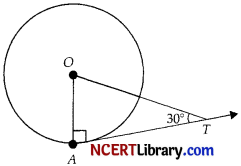
Answer:
\(\cos \theta=\frac{\text { Base }}{\text { Hypotenuse }}\)
\(\frac{AT}{OT}\) = cos 30°
∴ AT = OT cos 30°
or, AT = 4 × \(\frac{\sqrt{3}}{2}\)
= 2\(\sqrt{3}\)
Question 23.
In the given figure PQ is chord of length 6 cm of the circle of radius 6 cm. TP and TQ are tangents to the circle at points P and Q respectively. Find ∠PTQ. [2]
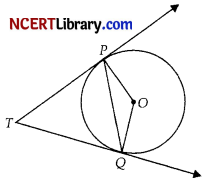
Answer:
Here, PQ = 6 cm,
OP OQ = 6 cm
∴ PQ = OP = OQ
∴ ∠POQ = 60°
(angle of equilateral A)
∠P = ∠Q = 90°
(radius ⊥ tangent)
∴ ∠PTQ + 90° + 90° + 60°= 360°
(angle sum property)
∠PTQ = 120°
![]()
Question 24.
If the length of the ladder placed against a wall is twice the distance between the foot of the ladder and the wall. Find the angle made by the ladder with the horizontal. [2]
OR
From the top of light house, 40 m above the water, the angle of depression of a small boat is 60°. Find how far the boat is from the base of the light house. [2]
Answer:
Let the distance between the foot of the ladder and the wall, AB be x.
then AC, the length of the ladder = 2x
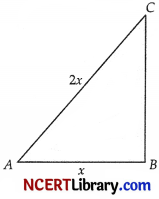
In ∆ABC,
∠B = 90°
cos A = \(\frac{x}{2x}\)
⇒ cos A = \(\frac{1}{2}\) = cos 60° ⇒ A = 60°
OR
Let AB be the light house and C be the position of the boat.
Since, ∠PAC = 60°
∴ ∠ACB = 60°
Let BC be x m.
In ∆ABC,
\(\frac{A B}{B C}\) = tan 60°
⇒ \(\frac{40}{x}\) = \(\sqrt{3}\)
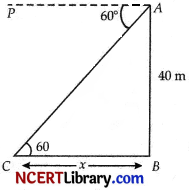
⇒ \(x=\frac{40}{\sqrt{3}} \times \frac{\sqrt{3}}{\sqrt{3}}\)
= \(\frac{40 \sqrt{3}}{3}\)
Hence, the boat is \(\frac{x}{2x}\) m away from the foot of the light house.
Question 25.
Find the number of metallic circular discs with 1.5 cm base diameter and of height 0.2 cm to be melted to form a right circular cylinder of height 10 cm and diameter 4.5 cm. [2]
Answer:
Required number of metallic discs = \(\frac{\text { Volume of right circular cylinder }}{\text { Volume of one metallic circular discs }}\)
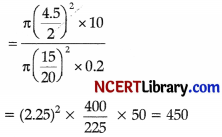
Therefore, required number of metallic discs = 450
Section – C
Section C consists of 6 Questions of 3 marks each.
Question 26.
Prove that 3 + \(\sqrt{5}\) is an irrational number.
Answer:
Let 3 + \(\sqrt{5}\) is a rational number.
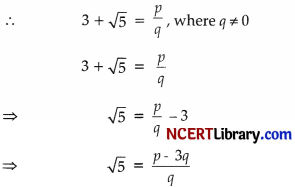
\(\sqrt{5}\) is is irrational and \(\frac{p-3 q}{q}\) is rational (as assumed).
But rational number cannot be equal to an irrational number.
∴ 3 + \(\sqrt{5}\) is an irrational number.
Question 27.
Ifl + 4 + 7 + 10 ………. + x = 287, find the value of x.
OR
The sum of first 7 terms of an A.E is 63 and sum of its next 7 terms is 161. Find 28th term of A.P.
Answer:
Given, a = 1 and d = 3.
Let number of terms in the series be n.
Sn = \(\frac{n}{2}\)[2a + (n – 1)d]
\(\frac{n}{2}\)[2 × 1 + (n – 1)3] = 287
or, \(\frac{n}{2}\)[2 + (3n – 3)\ = 287
or, 3n² – n = 574
or, 3n² – n – 574 = 0
or, 3 n² -42n + 41n – 574 = 0
or, 3n(n – 14) + 41 (n – 14) = 0
or, (n – 14)(3n + 41) = 0
n = 14
or, n = –\(\frac{41}{3}\), it is not possible
Thus, the 14th term is x,
a + (n – 1)d = x
or, 1 + 13 × 3 = x
Hence, x = 40
OR
Since, S1 = \(\frac{n}{2}\) [2A + (M – l)d]
Given, S7 = 63
Hence, S7 = \(\frac{7}{2}\) [2a + 6 d] = 63
or, 2a + 6d = 18 …….(i)
Now, sum of 14 terms is
S14 = Sfirst 7 + Snext 7
= 63 + 161
= 224
\(\frac{14}{2}\)[2a + 13d] = 224
or, 2a + 13 d = 32 …… (ii)
On subtracting (i) from (ii), we get
(2a + 13d) – (2a + 6d) = 32 – 18
7d = 14 or, d = 2
Putting the value of d in (i), we get
a = 3
Since, an = a + (n – 1 )d
∴ S28 – 3 + 2 × (27) = 57
∴ The 28th term =57
![]()
Question 28.
Find the zeroes of the quadratic polynomial \(\sqrt{3}\) x² – 8x + 4\(\sqrt{3}\). [3]
Answer:
Let p(x) = \(\sqrt{3}\)x² – 8x + 4 \(\sqrt{3}\)
∴ p(x) = 0
\(\sqrt{3}\)x² – 6x – 2x + 4 \(\sqrt{3}\) = 0
\(\sqrt{3}\) x (x – 2 \(\sqrt{3}\)) – 2(x – 2 \(\sqrt{3}\)) = 0
(\(\sqrt{3}\)x – 2)(x – 2\(\sqrt{3}\)) = 0
x = \(\frac{2}{\sqrt{3}}\) or 2\(\sqrt{3}\)
∴ Zeroes are \(\frac{2}{\sqrt{3}}\) and 2\(\sqrt{3}\).
Question 29.
Prove that the parallelogram circumscribing a circle is a rhombus.
Answer:
Let ABCD be the || gm.
∴ AB = CD and AD = BC …(i)
AP + PB + DR + CR = AS + BQ + DS + CQ
or, AB + CD = AD + BC
From (i), 2AB = 2AD or AB = AD
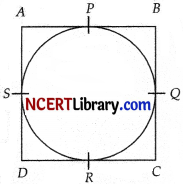
or, ABCD is a rhombus
Question 30.
Prove that: \(\frac{\sin \theta-\cos \theta}{\sin \theta+\cos \theta}+\frac{\sin \theta+\cos \theta}{\sin \theta-\cos \theta}=\frac{2}{2 \sin ^2 \theta-1}\).
OR
Prove that:\(\frac{\cos A}{1+\tan A}-\frac{\sin A}{1+\cot A}=\cos A-\sin A\).
Answer:
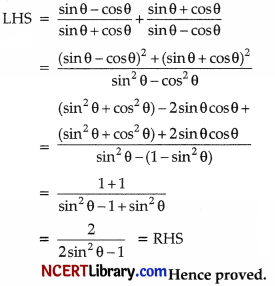
OR
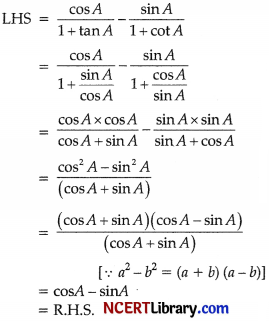
Question 31.
Three different coins are tossed together. Find the probability of getting
(i) exactly two heads.
(ii) at least two heads
(iii) at least two tails.
Answer:
Possible outcomes are
{HHH, HHT, HTH, THH, HTT, THT, TTH, TTT}
⇒ n(S) = 8
(i) Exactly two heads, E1
= {HHT, HTH, THH}
n(E1) = 3
∴ P(E1) = \(\frac{n(P_1)}{n(S)}\) = \(\frac{3}{8}\)
(ii) At least two heads, E2 = {HHT, HTH, THH, HHH}
n(E2) = 4
P(E2) = \(\frac{n(P_2)}{n(S)}\) = \(\frac{4}{8}\) = \(\frac{1}{2}\)
(iii)At least two tails, E3 = {TTH, THT, HTT, TTT}
n(E3) = 4
P(E3) = \(\frac{n(P_3)}{n(S)}\) = \(\frac{4}{8}\) = \(\frac{1}{2}\)
![]()
Section – D
Section D consists of 4 Questions of 5 marks each.
Question 32.
Solve the following pair of linear equations graphically :
x + 3y =6 and 2x – 3y = 12.
Also, shade the region bounded by the line 2x – 3y = 12 and both the co-ordinate axes. [5]
OR
The denominator of a fraction is one more than twice its numerator. If the sum of the fraction and its reciprocal is
\(2 \frac{16}{21}\) , find the fraction.
Answer:
Given, x + 3y = 6 or y = \(\frac{6-x}{3}\) …..(i)
| x | 3 | 6 | 0 |
| y | 1 | 0 | 2 |
and 2x – 3y = 12
⇒ y = \(\frac{2x-12}{3}\)
| x | 0 | 6 | 3 |
| y | -4 | 0 | -2 |
Plotting the above points and drawing lines joining them, we get the graphs of the equations x + 3y = 6 and 2x -3y = 12.
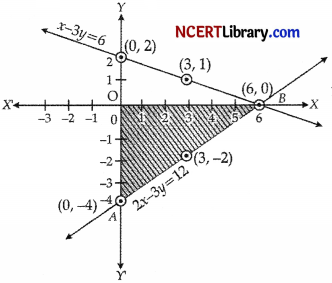
The two lines intersect each other at point B (6,0).
Hence, x = 6 and y = 0.
Again, AOAB is the region bounded by the line 2x – 3y = 12 and both the co-ordinate axes.
OR
Let numerator be x.
Then, the fraction = \(\frac{x}{2x + 1}\)
Again, \(\frac{x}{2x + 1}\) + \(\frac{2x + 1}{x}\) = \(\frac{58}{21}\)
⇒ 21 [x² + (2x + 1)²] = 58 (2x² + x)
⇒ 11x² – 26x – 21 = 0
11x² + 33x – 7x – 21 = 0
x = 3 or – \(\frac{7}{11}\) (rejected negative value)
Hence, fraction = \(\frac{3}{7}\)
Question 33.
In the given figure, D and £ trisect BC. Prove that 8AE2 = 3AC2 + 5AD2.
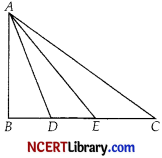 OR
OR
In figure, PQ is a chord of length 16 cm, of a circle of radius 10 cm. The tangents at P and Q intersect at a point T. Find the length of TP. [5]
Answer:
Let BD = DE = EC be x
BE = 2x
and BC = 3x
Now, in ∆ABE
AE2 = AB2 + BE2
= AB2 + 4x2 …..(i)
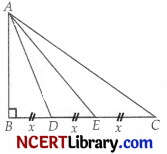
In ∆ABC,
AC2 = AB2 + BC2
= AB2 + 9x2
In ∆ADB,
and AD2 = AB2 + BD2 = AB2 + x2
On multiplying (i) by 8, we get
8AE2 = 8AB2 + 32x2 …(ii)
Now, RHS = 3AC2 + 5AD2 = 3 (AB2 + 9x2) +5 (AB2 + x2)
= 8AB2 + 32x2 = 8 (AB2 + 4x2)
∴ 3AC2 + 5AD2 = 8AE2. [From eqns (ii)]
Hence Proved.
OR
Given, OM ⊥ PQ, bisects PQ.
∴ PM= 8 cm (as PQ = 16 cm)
In rt. ∆OMP,
OM = \(\sqrt{(10)^2+(8)^2}\)
= \(\sqrt{100 – 64}\)
= \(\sqrt{36}\)
= 6 cm
∠TPM + ∠MPO = 90°
Also, ∠TPM + ∠PTM = 90°
∠MPO = ∠PTM
∠TMP = ∠OMP = 90°
∆TMP ~ ∆PMO (AA)
or, \(\frac{TP}{PO}=\frac{MP}{MO}\)
\(\frac{TP}{10}=\frac{8}{6}\)
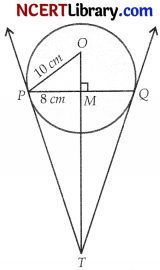
or, TP = \(\frac{80}{6}\)
or, TP = \(\frac{40}{3}\)
Hence length of TP = \(\frac{40}{3}\).
![]()
Question 34.
From a solid cube of side 14 cm, a conical cavity of height 14 cm and radius 6 cm is hollowed out. Find the volume of the remaining solid. [5]
Answer:
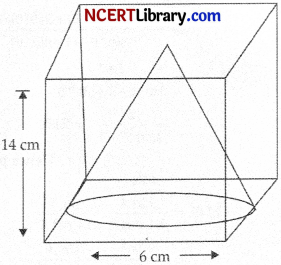
From the figure, we get
Volume of remaining solid = Volume of cube – volume of cone
For cube,
Given, side = 6 cm
∴ volume of cube = (14)³ = 2744 cm³
[∵ volume of cube = (side)³]
For cone,
Given, radius r = 6 cm
height, h = 14 cm
∵ Volume of cone = \(\frac{1}{3}\)πr2h
= \(\frac{1}{3}\) × \(\frac{22}{7}\) × 62 × 14
= \(\frac{1}{3}\) × \(\frac{22}{7}\) × 36 × 14
= 528 cm³
Therefore, volume of remaining solid = 2744 – 528
= 2216 cm³
Question 35.
The weights of coffee in 70 packets are shown in the following table.
| Weight (in g) | 200-201 | 201-202 | 202-203 | 203-204 | 204-205 | 205-206 |
| Number of packets | 12 | 26 | 20 | 9 | 2 | 1 |
Determine the modal weight.
Answer:
| C.I. | f<sub>i</sub> |
| 200-201 | 12 |
| 201-202 | 26 |
| 202-203 | 20 |
| 203-204 | 9 |
| 204-205 | 2 |
| 205-206 | 1 |
Modal class = (201-202)
[Maximum frequency is 26]
f0 = 12
f1 = 26
f2 = 20
h = 201 – 200 = 1
l = 201
\(\text { Mode }=l+\left[\frac{f_1-f_0}{2 f_1-f_0-f_2}\right] h\)
\(\text { Mode }=201+\left[\frac{26-12}{2×26-12-20}\right] \)
= \(201+\left[\frac{14}{52-13}\right] \)
= 201 + 0.7 = 201.7
Mode = 201.7
Therefore, the modal weight is 201.7 g.
Section – E
Case study based questions are compulsory.
Question 36.
The speed of a motor boat is 20 km/hr. For covering the distance of 15 km the boat took 1 hour more for upstream than downstream.

I. If speed of the stream be x km/h, then find the speed of the motorboat in upstream.
II. Write the relation between speed, distance and time?
III. Find the quadratic equation for the speed of the current?
OR
What is the speed of current?
Answer:
I. We have, speed of the stream be x km/h Speed of a motor boat is 20 km/h So the speed of motorboat in upstream will be (20 – x) km/h.
The speed will be less in upstream journey.
II. speed = \(\frac{\text { distance }}{\text { time }}\)
Speed is the distance travelled per unit time.
III. Let speed of the stream be x km/h.
For covering the distance of 15 km the boat took one hour more for upstream than downstream.
We have,
⇒ \(\frac{15}{20-x}\) – \(\frac{15}{20+x}\) = 1
On simplifying we get,
x² + 30x – 400 = 0
OR
On solving the quadratic equation x² + 30x – 400 = 0
We get, x = 10 and – 40(rejected)
So the speed of the current is 10 km/h
![]()
Question 37.
In a room, 4 friends are seated at the points A, B, C and D as shown in figure. Reeta and Meeta walk into the room and after observing for a few minutes, Reeta asks Meeta.
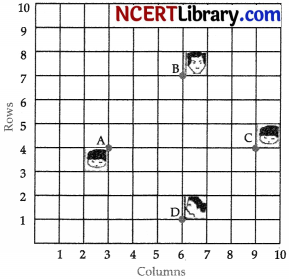
I. What is the position of A and D ?
II. What is the middle position of B and C ?
III. What is the distance between A and B ?
OR
What is the equation of line CD ?
Answer:
I. Point A lies in x = 3 and y = 4.
∴ A (3, 4) is the correct position.
Point D lies at x = 6 and y = 1.
So, the correct position of D is (6,1).
II. Position of B = (6, 7)
and position of C = (9,4)
Mid-point of B and C = \(\frac{6+9}{2},\frac{7+4}{2}\)
= \(\frac{15}{2},\frac{11}{2}\)
III. Position of A = (3, 4)
Position of B = (6, 7)
∴ Distance of AB =
= |\(\sqrt{(3-6)^2 +(4-7)^2}\)|
= |\(\sqrt{(-3)^2 +(-3)^2}\)|
= \(\sqrt{18}\) = \(3 \sqrt{2}\) units
OR
∴ Equation of line CD = equation of line through
C (9, 4) and D(6,1)
i.e., y – 4 = \(\frac{1-4}{6-9}\)(x – 9)
⇒ y – 4 = x – 9
⇒ x – y – 5 = 0
![]()
Question 38.
‘Skysails’ is that genre of engineering science that uses extensive utilization of wind energy to move a vessel in the sea water. The sky sails technology allows the towing kite to gain a height of anything between 100 m to 300 m. The sailing kite is made in such a way that it can be raised to its proper elevation and then brought back with the help of a telescopic mast that enables the kite to be raised properly and effectively.
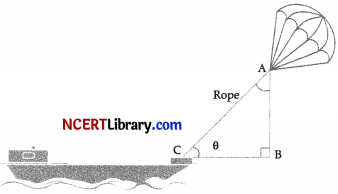
I. Find the value of tan 30°. cot 60°.
II. What should be the length of the rope of the kite sail in order to pull the ship at the angle 0 and be at a vertical height of 200 m ?
III. If cos A = \(\frac{1}{2}\), then find the value of 9 cot²A – 1.
OR
In the given figure, find the value of (sin C + cos A).
Answer:
I. \(\tan 30^{\circ} \times \cot 60^{\circ}=\frac{1}{\sqrt{3}} \times \frac{1}{\sqrt{3}}=\frac{1}{3}\)
II. In AABC,
θ = 30°, AB = 200 m
Then, sin 30° = \(3 \sqrt{2}\)
= \(\frac{AB}{AC}\)
⇒ \(\frac{1}{2}=\frac{200}{AC}\)
⇒ AC = 400 m
III. Given, cos A = \(\frac{1}{2}\)
⇒ cos A = cos 60°
⇒ A =60°
Then, 9 cot² A – 1 =9(cot 60°)² – 1
= 9(\(\frac{1}{\sqrt{3}}\))² – 1
= 9 × \(\frac{1}{3}\) – 1 = 3 – 1
=2
OR
We have,
AB = 200 m and AC = 400 m
[Proved in Q.II]
Then, sin C + cos A = \(\frac{AB}{AC}\)+\(\frac{AB}{AC}\)
= \(\frac{200}{400}\)+\(\frac{200}{400}\)
= \(\frac{1}{2}\)+\(\frac{1}{2}\)
= \(\frac{2}{2}\) = 1